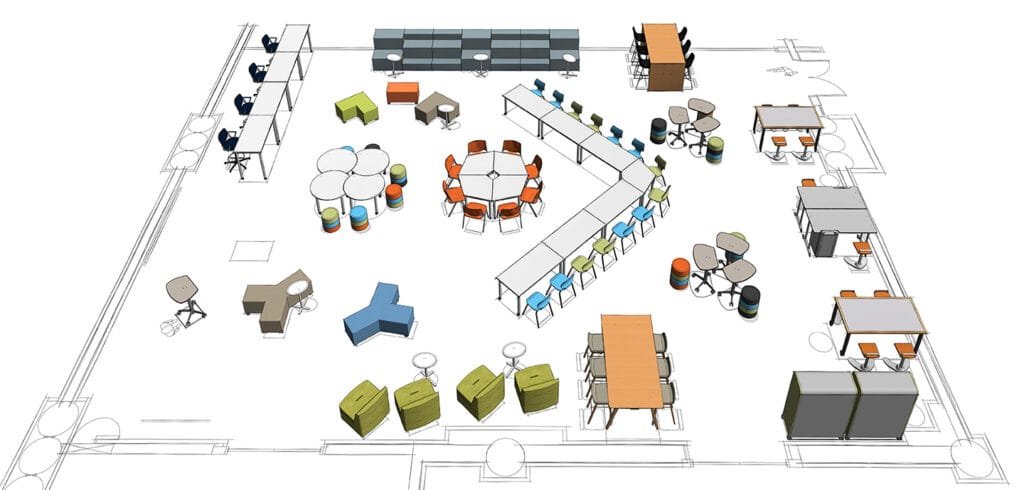1. Introduction:The Impact of Classroom Furniture on the Learning Environment

In modern education, the classroom serves as much more than just a space for transferring knowledge—it is a vital area for student growth, interaction, and exploration. The furniture chosen for the classroom plays a pivotal role in shaping students’ learning experiences, their ability to concentrate, and even their physical well-being. Comfortable, safe, and durable furniture not only promotes a positive educational atmosphere but also enhances cognitive function and productivity.
On the other hand, inappropriate classroom furniture can lead to a range of issues, including discomfort, lack of focus, and even health problems such as back pain, neck strain, or poor posture. These problems are often caused by poorly designed desks, uncomfortable chairs, or furniture that does not meet ergonomic standards. Therefore, selecting the right classroom furniture is crucial for improving the overall quality of education and ensuring the well-being of students.
Pain Point
Many schools and educational institutions, when updating or purchasing classroom furniture, focus primarily on price or aesthetics, neglecting essential aspects such as comfort, safety, and durability. This is a common pitfall. Poorly designed furniture—particularly desks and chairs that do not follow ergonomic principles—has been identified as a leading cause of long-term health problems for students, especially during their formative years.
For instance, inadequate desk and chair height can lead to chronic back pain or muscle strain, significantly hindering a student’s ability to concentrate during lessons. Furthermore, furniture with sharp edges or unsafe designs can cause injuries, disrupting the classroom environment. Over time, poor-quality furniture can also increase maintenance and replacement costs, burdening the school budget with ongoing repairs or the need for more frequent replacements.
Recent studies show that around 68% of students experience discomfort or health issues due to improper seating arrangements, making it clear that investing in durable, ergonomic furniture is not only a financial decision but also a health and safety necessity for students and educators alike.
2. Ideal Features of a Classroom: Creating a Positive Learning Environment
Creating the ideal classroom involves more than just aesthetic appeal—it requires thoughtful consideration of furniture characteristics that meet both educational and physical needs. Here are the key elements to consider when choosing classroom furniture:

Charterhouse Lagos School Project by Hongye Furniture Group
Core Elements of Classroom Furniture Design
- Ergonomic Design
One of the most important aspects of classroom furniture is its ergonomic design. Furniture that promotes good posture is essential for ensuring that students are comfortable during long hours of learning. An ergonomically designed desk and chair will support the body in a way that reduces pressure on the spine, neck, and shoulders, preventing discomfort and musculoskeletal issues over time. For example, adjustable desks and chairs with lumbar support allow students to tailor the furniture to their individual needs, minimizing strain and supporting proper posture throughout the school day. - Safety
Safety is paramount in any educational setting. Classroom furniture should be designed with rounded edges and no sharp corners to reduce the risk of injury. A safe classroom environment ensures that students are free to move around without fear of accidents. Furniture with stabilizing bases and secure fittings prevents tipping, especially in high-traffic areas. Moreover, choosing non-toxic materials in the construction of classroom furniture is critical for ensuring the health and safety of students. Schools should look for furniture that adheres to safety regulations and standards for child safety. - Durability
Durability is another crucial factor when selecting classroom furniture. Schools invest significant resources in purchasing and maintaining furniture, so it’s essential to choose materials that can withstand the wear and tear of daily use. High-quality materials, such as steel frames, laminate surfaces, and scratch-resistant finishes, can ensure that the furniture lasts longer and remains functional, even in high-traffic classrooms. To better illustrate the importance of durability, let’s take a look at the long-term cost-effectiveness of choosing durable furniture compared to cheaper alternatives. As seen in the table above, although the initial cost of durable furniture might be slightly higher, the overall cost over five years is significantly lower due to reduced repair and replacement needs. This long-term value makes durable furniture a much better investment for schools. - Adjustability
Flexible and adjustable furniture is key to accommodating students of various sizes and ages. Desks and chairs with adjustable heights allow for easy customization, ensuring that students remain comfortable and maintain good posture regardless of their height. In classrooms where multiple age groups or grade levels are taught, adjustable furniture provides the versatility needed to create a more personalized learning experience for each student. Adjustable features also contribute to flexible classroom layouts. Schools can easily rearrange desks and chairs to suit different teaching styles or group activities, further enhancing the learning environment. - Environmental Sustainability
Today’s educational institutions are increasingly aware of the need to choose environmentally friendly furniture. Schools should prioritize green furniture options that adhere to sustainable practices and meet eco-friendly standards. Furniture made from recyclable materials or non-toxic finishes minimizes harmful emissions, ensuring that students are not exposed to harmful chemicals. Selecting eco-friendly classroom furniture not only supports the well-being of students but also aligns with the growing emphasis on sustainability in educational spaces. Furniture with certifications like GREENGUARD ensures that the furniture does not contribute to indoor air pollution or other environmental hazards.
3. Guide to Choosing Durable and Safe Classroom Furniture
When selecting classroom furniture, durability, safety, and sustainability are key considerations. Understanding the different materials and design features will help you make an informed decision that ensures a healthy, comfortable, and long-lasting learning environment for students. Here, we’ll dive into the essential aspects of choosing durable, safe, and eco-friendly classroom furniture.

Dasixiang Primary School(Jiangnan Campus) | Education Project by Hongye Furniture
A. Material Selection: High-Density Fiberboard, Steel Frames, or Eco-Friendly Plastics
- High-Density Fiberboard (HDF)
High-Density Fiberboard is widely used in school furniture for its exceptional stability, durability, and impact resistance. This material is engineered from compressed wood fibers, making it strong and capable of withstanding the daily wear and tear of a busy classroom environment. HDF surfaces are resistant to scratches, dents, and moisture, which makes it an excellent choice for high-traffic areas like classrooms.- Pros:
- Durability: Resistant to daily wear, ensuring longevity.
- Cost-Effective: Generally less expensive than solid wood but offers comparable strength.
- Sustainability: Can be made from recycled materials, making it an eco-friendly option.
- Cons:
- Can be susceptible to moisture damage if not properly sealed.
- Not as visually appealing as natural wood finishes.
- Pros:
- Steel Frames
Steel is one of the most durable materials available for classroom furniture. It provides superior stability and strength, ensuring that desks and chairs remain solid and sturdy even under heavy use. Steel frames are highly resistant to bending or warping over time.- Pros:
- Longevity: Steel is virtually indestructible and can last for decades.
- Strength: Provides exceptional support for desks and chairs.
- Easy to Maintain: Steel surfaces are easy to clean and resistant to many chemicals.
- Cons:
- Weight: Steel furniture can be heavy, making it difficult to move.
- Cost: Generally, steel-framed furniture is more expensive upfront compared to plastic or wood alternatives.
- Pros:
- Eco-Friendly Plastics
Eco-friendly plastics are becoming an increasingly popular choice for classroom furniture. These materials are lightweight, durable, and often designed to resist high temperatures and wear. However, it’s essential to ensure that the plastics used are free from harmful chemicals like BPA and phthalates.- Pros:
- Lightweight: Makes it easier to rearrange furniture and move pieces for different activities.Durable: Resistant to high temperatures and abrasion.Sustainable: Often made from recycled materials or recyclable plastics.
- May not have the same premium look as wood or steel furniture.Needs to meet eco-certifications to guarantee safety and environmental responsibility.
- Pros:
| Material | Pros | Cons |
| High-Density Fiberboard (HDF) | Cost-effective, durable, eco-friendly, resistant to scratches and moisture | Can be damaged by moisture if not sealed correctly |
| Steel Frames | Highly durable, stable, easy to clean | Heavy, expensive |
| Eco-Friendly Plastics | Lightweight, durable, sustainable, resists wear and high temperatures | Highly durable, stable, and easy to clean |
B. Design Considerations: Adjustable Desks and Chairs, Rounded Corner Design
- Adjustable Desks and Chairs
Adjustable desks and chairs are a must-have for any modern classroom. These pieces of furniture allow for height adjustments to accommodate students of various sizes, ensuring that they can sit comfortably and maintain proper posture. With adjustable features, the furniture can adapt as students grow, promoting better ergonomics and reducing the risk of musculoskeletal problems like back pain or neck strain.- Benefits of Adjustable Furniture:
- Ergonomically Friendly: Helps students maintain proper sitting posture, reducing discomfort.
- Long-Term Use: As students grow, the furniture can adjust to fit their size, reducing the need for frequent replacements.
- Encourages Movement: Adjustable furniture can promote better flexibility in the classroom layout, making it easier to switch from individual work to group activities.
- Benefits of Adjustable Furniture:
- Rounded Corner Design
Safety is paramount when selecting classroom furniture, especially when children are involved. Sharp corners and edges can pose significant injury risks during classroom activities. To mitigate these risks, rounded corner design is highly recommended for all classroom furniture, including desks, chairs, and storage units.- Safety Benefits:
- Prevents Injury: Rounded corners reduce the likelihood of students getting injured if they bump into furniture during movement or play.
- Better Flow in the Classroom: Rounded designs allow for better movement and ease of access in tightly spaced areas, ensuring students can navigate through the room safely.
- Safety Benefits:
C. Environmental Standards: Choosing Furniture That Meets National Eco-Friendly Guidelines
Selecting classroom furniture that meets eco-friendly standards is crucial for both the environment and the health of students. Non-toxic furniture reduces the exposure of harmful substances like formaldehyde, benzene, or other volatile organic compounds (VOCs), which are often found in lower-quality, poorly manufactured furniture.
Here are some key eco-certifications to look for:
- CARB2 Compliance (California Air Resources Board): This certification ensures that the furniture meets strict limits for formaldehyde emissions, which can be harmful to students’ health.
- GREENGUARD Certification: This is a leading certification for indoor air quality, confirming that the furniture is free of harmful chemicals and contributes to a safer and healthier classroom environment.
- FSC Certification (Forest Stewardship Council): For furniture made from wood, an FSC-certified product ensures that the wood is sourced sustainably, contributing to environmental conservation efforts.
By choosing furniture that meets these green standards, schools can not only reduce their environmental footprint but also ensure that students are not exposed to harmful chemicals or pollutants that could affect their health and learning.
4. Safety and Maintenance of Classroom Furniture
When selecting classroom furniture, ensuring safety and longevity is essential for creating a secure and comfortable learning environment. By focusing on safety certifications, regular inspections, and proper maintenance, schools can ensure that their furniture remains safe and functional for years to come. Let’s explore how you can ensure the safety and durability of your classroom furniture.

A. Safety Certifications and Testing
One of the most important steps in choosing safe classroom furniture is ensuring that it has undergone rigorous testing and holds third-party safety certifications. These certifications confirm that the furniture meets established international safety standards, minimizing the risk of injury or accidents.
Common Safety Certifications for Classroom Furniture include:
- EN 1729 (European Standard):
This certification ensures that classroom furniture complies with ergonomic and safety requirements for chairs and desks used in educational settings. It addresses aspects such as height adjustability, stability, and structural integrity. - ANSI/BIFMA (American National Standards Institute / Business and Institutional Furniture Manufacturers Association):
This certification is often seen on commercial furniture in the United States. It ensures that the furniture meets safety, performance, and durability standards, including tests for flammability, toxicity, and strength. - Greenguard Certification:
In addition to safety, Greenguard certification ensures that the furniture is low in volatile organic compounds (VOCs), which can contribute to indoor air pollution. This is crucial for maintaining a healthy classroom environment.
By selecting furniture with recognized certifications, schools can ensure the safety, ergonomics, and environmental health of the furniture.
B. Regular Inspection and Maintenance
Even the highest-quality classroom furniture requires regular inspection and maintenance to ensure that it continues to function safely over time. Furniture can wear out, get damaged, or become unstable with frequent use. Regular checks are vital to ensure the safety of students and teachers.
How to Inspect Classroom Furniture:
- Check Stability: Ensure that chair legs are securely attached, and desks do not wobble. Check for any loose or missing screws, bolts, or joints.
- Examine for Cracks or Damage: Inspect tabletops, seats, and backs for cracks, splits, or chips that could lead to further damage or injury.
- Ensure Proper Functionality: For adjustable desks and chairs, test the adjustability mechanisms to ensure they still work smoothly and securely.
- Look for Sharp Edges: Verify that all corners are rounded to prevent injury. Also, ensure that there are no exposed, sharp edges that could cause cuts.
Maintenance Tips:
- Cleaning: Regular cleaning with non-abrasive materials will prevent dust and grime from accumulating, which can cause wear and tear over time.
- Lubrication: For movable parts like desk drawers or chair adjustments, apply appropriate lubricants to keep them functioning smoothly.
- Repairs: For minor issues, such as loose screws or small cracks, repairs should be made immediately to avoid further damage and maintain safety.
Creating a regular maintenance schedule and designating responsible staff members will help ensure the furniture remains in good condition and avoids potential safety risks.
5. Call to Action
When it comes to selecting the right classroom furniture, partnering with a professional supplier who understands the specific needs of your school is crucial. At Hongye Furniture, we specialize in providing ergonomic, durable, and safe classroom furniture solutions tailored to your educational environment.
We offer a wide range of customizable options to match your classroom layout, budget, and teaching objectives. Our expert team will help you design the ideal furniture configuration that promotes student comfort, safety, and productivity.
Visit Hongye today to receive a free classroom furniture design consultation, learn more about our custom solutions, and take advantage of our exclusive offers.
Let us help you create a safer, more comfortable, and efficient learning environment for your students!


